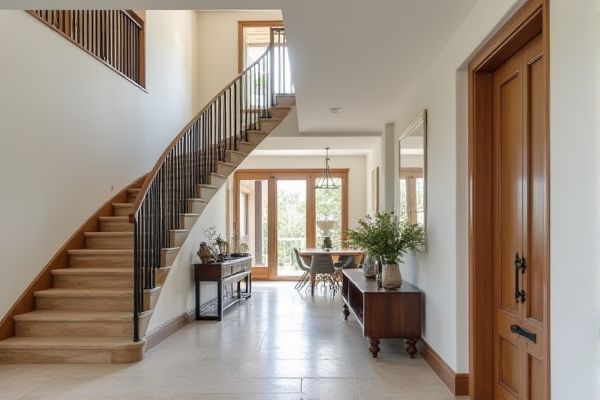
Curved railings offer a modern, artistic appeal and can enhance the flow of spaces with their smooth, graceful lines, while straight railings provide a classic, clean-cut look that suits minimalist or traditional designs. To discover which railing style best fits your aesthetic and functional needs, read on for a detailed comparison.
Table of Comparison
| Feature | Curved Railings | Straight Railings |
|---|---|---|
| Design | Elegant, flowing, adds architectural interest | Simple, clean lines, classic look |
| Installation | Complex, requires custom fabrication | Easy, standard sizes available |
| Cost | Higher due to customization and labor | Lower, more affordable materials and labor |
| Material Compatibility | Best with flexible metals like wrought iron or stainless steel | Works with most materials including wood, metal, and glass |
| Durability | Durable but depends on bending quality | Highly durable, less structural stress |
| Aesthetic Impact | Creates a dramatic, artistic statement | Offers minimalistic and modern appeal |
| Safety | Safe if built to code; curvature must avoid gaps | Standard safety features, easier compliance |
Introduction to Curved vs Straight Railings
Curved railings offer a dynamic and elegant design that enhances architectural aesthetics by following the contours of staircases or walkways, providing a smooth, organic flow. Straight railings deliver a clean, modern look with geometric simplicity, making them ideal for minimalist or contemporary spaces. Both options ensure safety and durability, but the choice depends on the desired visual impact and structural requirements.
Aesthetic Appeal: Curved vs Straight Designs
Curved railings offer a dynamic and elegant aesthetic appeal by creating smooth, flowing lines that enhance architectural features and soften the overall look of a space. In contrast, straight railings provide a clean, modern, and minimalist appearance that emphasizes geometric precision and structural simplicity. The choice between curved and straight designs significantly impacts the visual harmony and style of interior or exterior environments, influencing the perception of space and movement.
Space Utilization and Layout Flexibility
Curved railings enhance space utilization by following natural room contours, allowing for smoother traffic flow and maximizing usable area, especially in irregular or confined spaces. Straight railings provide layout flexibility due to their modular design, making installation and future modifications more straightforward while accommodating linear architectural features. Choosing the right railing depends on your space's shape and the balance between aesthetic flow and practical adaptability.
Material Options for Both Railing Types
Curved railings and straight railings both offer diverse material options, including stainless steel, aluminum, wood, and glass, each providing unique aesthetic and functional benefits. Curved railings often utilize flexible materials like wrought iron and custom-bent wood to achieve smooth, flowing shapes, while straight railings favor rigid materials such as square aluminum or pre-cut wood for clean, linear designs. Glass panels and metal balusters can be integrated into either style, enhancing durability and modern appeal while accommodating various architectural needs.
Installation Complexity and Labor Costs
Curved railings require more intricate installation processes due to the need for precise bending and custom fitting, resulting in higher labor costs compared to straight railings. Straight railings benefit from simpler, standardized components that streamline installation and reduce labor time. Contractors typically charge a premium for curved railing projects because of the specialized skills and additional time involved.
Structural Strength and Durability Comparison
Curved railings distribute weight and stress more evenly along their arc, enhancing structural strength and resistance to impact compared to straight railings, which may concentrate forces at linear joints. Materials like wrought iron and stainless steel in curved designs show greater durability by accommodating thermal expansion and reducing stress fractures over time. The inherent geometry of curved railings also contributes to improved longevity in high-traffic or outdoor environments due to better load dispersion and resistance to bending or warping.
Safety Considerations for Curved and Straight Railings
Curved railings offer enhanced safety by providing continuous hand support along bends, reducing the risk of falls on staircases and ramps with turns. Straight railings typically allow easier installation of consistent height and spacing, ensuring compliance with building codes and accessibility standards. Your choice should prioritize secure grip, durability, and proper anchoring to maximize safety in any architectural design.
Maintenance Requirements and Longevity
Curved railings often require more maintenance than straight railings due to their complex shapes, which can trap dirt and moisture, increasing the risk of rust or wear especially in metal materials like wrought iron or aluminum. Straight railings typically have simpler designs that allow for easier cleaning and inspection, contributing to longer durability with minimal upkeep. Both types made from high-quality materials such as stainless steel or treated wood benefit from protective coatings that enhance longevity and reduce maintenance frequency.
Cost Analysis: Curved vs Straight Railings
Curved railings typically incur higher costs due to complex fabrication and installation processes, requiring precise measurements and skilled labor, whereas straight railings benefit from standardized manufacturing and simpler assembly, reducing expenses. Material wastage tends to be greater with curved railings, further elevating overall project costs compared to straight railings. Budget-conscious projects often favor straight railings for cost efficiency, though curved designs add aesthetic value and customization options worth considering.
Choosing the Right Railing for Your Space
Curved railings offer a dynamic, elegant appeal that complements rounded staircases and architectural features, enhancing both aesthetics and safety. Straight railings provide clean, modern lines ideal for minimalist designs and straightforward staircases, ensuring functionality with a timeless look. Selecting between curved and straight railings depends on staircase shape, design goals, and the desired balance between style and practicality.
 homyna.com
homyna.com